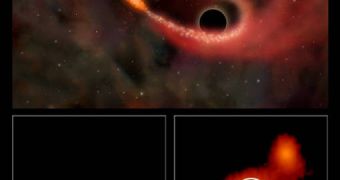A US-European astronomy team has recently announced at the European Week of Astronomy and Space Science meeting that it has discovered water spewing out of a black hole, at the center of a galaxy located billions of light-years away. The radio wavelength emissions that were observed in 2007 with the 100-meter German Effelsberg radio telescope and the Expanded Very Large Array showed a galaxy that emitted water from its core about 2.5 billion years after the Universe exploded into existence.
This means that the formation, which took all these billions of years to get its light from its location to us, was among the first generations of galaxies to be formed. Its water signature was detected as a wavelength marker. Each type of substance has a unique fingerprint on that scale, and water makes no difference. Scientists say that this discovery is very peculiar, and that extensive studies and new theories are needed to explain this phenomenon.
“We have been observing the water maser every month since the detection and seen a steady signal with no apparent change in the velocity of the water vapor in the data we've obtained so far. This backs up our prediction that the water is found in the jet from the supermassive black hole, rather than the rotating disc of gas that surrounds it,” Netherlands Institute for Radio Astronomy expert Dr. John McKean explained, as quoted by the BBC.
“The radiation that we detected has taken 11.1 billion years to reach the Earth. However, because the Universe has expanded like an inflating balloon in that time, stretching out the distances between points, the galaxy in which the water was detected is about 19.8 billion light years away,” the expert added. The Universe itself, researchers share, is only about 13.7 billion light-years in radius.
The new study has been made possible by an astronomical investigation technique called gravitational lensing. Basically, what this does is allow astronomers to use the way in which gravity influences light coming from closer galaxies as a telescope lens, in order to peer beyond them, into the early days of the Universe. Statistically speaking, there's a great possibility that more galaxies similar to the one recently discovered existed in the early days after the Big Bang. However, finding them is like looking for a needle in an infinite haystack.

 14 DAY TRIAL //
14 DAY TRIAL //